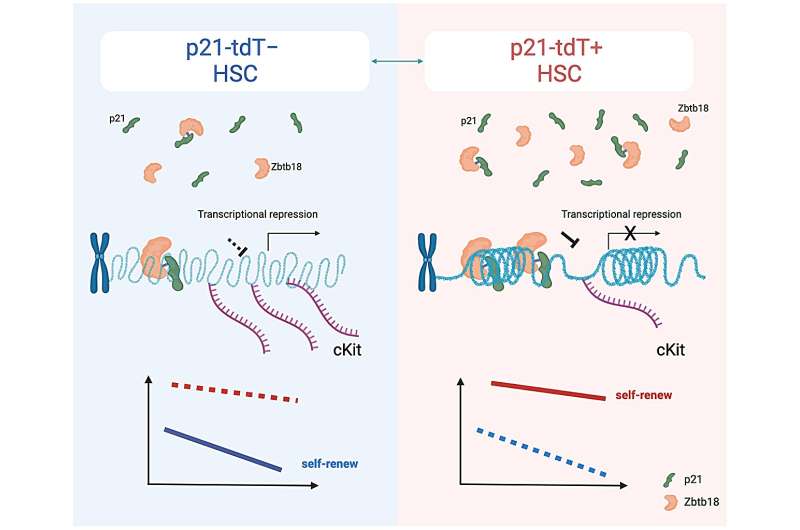This article has been reviewed according to Science X's editorial process and policies. Editors have highlighted the following attributes while ensuring the content's credibility:
fact-checked
proofread
Research highlights p21's multifunctional role beyond cell cycle control

A study addressing the complex regulation of HSCs, highlights p21's multifunctional nature beyond cell cycle control. Through the use of p21-tdTomato mice, researchers differentiate between p21-tdT+ and p21-tdT− HSCs.
Results show that p21-tdT+ HSCs display increased self-renewal and reconstitution abilities. Zbtb18, upregulated in p21-tdT+ HSCs, is crucial for their repopulation capability. p21 interacts with ZBTB18 to suppress cKit, influencing HSC self-renewal.
The work titled "Zbtb18 represses cKit expression to regulate the self-renewal of hematopoietic stem cells through interaction with p21" is published in Protein & Cell on May 9, 2024.
Key findings from the study include:
- Increased self-renewal capacity in p21-tdT+ HSCs: p21-tdT+ HSCs exhibit enhanced long-term reconstitution and self-renewal capabilities compared to p21-tdT− HSCs, as evidenced by a higher proportion of resting HSCs (rHSCs) post-myeloablation.
- Transcriptional regulation by p21 and Zbtb18: RNA-seq analysis reveals differential gene expression in p21-tdT+ HSCs, with Zbtb18 identified as highly expressed. Zbtb18 knockdown impairs HSC reconstitution, indicating its importance in the self-renewal process.
- Role of p21 in transcriptional repression: p21 interacts with ZBTB18 to co-repress cKit expression, contributing to the regulation of HSC self-renewal independently of its conventional cell cycle inhibitory function.
- Cell division kinetics of p21-tdT+ HSCs: p21-tdT+ HSCs undergo fewer cell divisions than p21-tdT− HSCs, suggesting they are in a relatively inactive state of the cell cycle, which correlates with their enhanced self-renewal capacity.
- ATAC-seq analysis reveals chromatin accessibility changes: p21-tdT+ HSCs show decreased chromatin accessibility and more transcriptionally repressed regions, yet some genes are upregulated, possibly due to p21's role in transcriptional regulation.
The research provides novel insights into p21's role in regulating HSC self-renewal during homeostasis, demonstrating its interaction with ZBTB18 to co-repress cKit expression. This study challenges the traditional view of p21 as merely a cell cycle inhibitor and highlights its multifaceted functionality in HSCs.
By distinguishing p21-tdT+ from p21-tdT− HSCs, the authors reveal that p21-tdT+ HSCs maintain greater self-renewal capacity, likely due to their reduced cell division and enhanced transcriptional regulation.
These findings contribute to a deeper understanding of the mechanisms governing HSC maintenance and could have implications for therapeutic interventions aimed at enhancing HSC function.
More information: Nini Wang et al, p21/Zbtb18 repress the expression of cKit to regulate the self-renewal of hematopoietic stem cells, Protein & Cell (2024). DOI: 10.1093/procel/pwae022
Provided by Higher Education Press


















